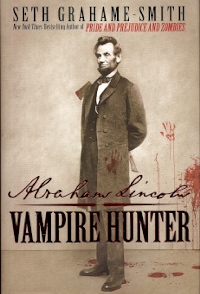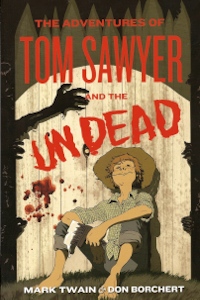I vividly remember trying to teach Pride and Prejudice to a class of high school juniors. Alas! These were not my best days as an educator. Most of my students found the novel boring. And that was just the girls. The boys on the football team didn’t like the book much either. Indeed, in this survey of American Literature, I was eager to get back to Edgar Allan Poe and then quickly work my way up to Twain, Hemingway and Steinbeck (even the offensive linemen loved Cannery Row).
Where was Seth Grahame-Smith when I needed him? I am pretty sure I could have drummed up a little more interest in Jane Austen’s classic if zombies had been involved.
All of this leads up to a short discussion of two of the latest entries into the fairly recent sub-sub-genre of horror that adapts classic works of literature and famous historical biographies to tell the stories as they “really” were, replete with zombies, vampires, werewolves, mummies and magic.
The Adventures of Tom Sawyer and the Undead was a bit disappointing to me. California librarian Don Borchert, who shares authorship with Mark Twain, has obviously done his homework. Borchert accurately recreates the 19th century Missouri village on the west bank of the Mississippi and its inhabitants.
Tom Sawyer is still a bright scalawag of a boy, always up to mischief, but with a good heart, a creative sense of adventure, and ripe for romance. Huck Finn is the likeable reprobate who acts as a catalyst in Tom’s maturation. And poor Aunt Polly is constantly frustrated in her efforts to control her charge. The big difference here is that the country has recently come under the threat of a plague of zombies, here called the “Zum.”
Instead of whitewashing the fence, Tom cozens his pals into helping him sharpen the pickets, the better to impale the Zum who might stumble into the yard bent on eating the family. After Doc Robinson is killed, he refuses to stay down and has to be thoroughly bound before being buried. Injun Joe is not just an amoral murderer, he is the first of a new evolution of Zum who do not just shamble about, but are capable of rational thought and planning.
The problem with this adaptation is that, although there is a lot of talk about the curse of the Zum, there just aren’t that many Zum in it. It takes nearly half the book before one actually shows up on its pages, and there are only a couple of incidents where Tom comes into contact with one. If the undead are going to share the title with Tom Sawyer, readers should expect a lot more undead.
The plot, tone and dialogue are very close to the original, but a few token zombies didn’t seem to me to add much.
 Abraham Lincoln Vampire Hunter is another matter. I thought the book was terrific.
Abraham Lincoln Vampire Hunter is another matter. I thought the book was terrific.
In Grahame-Smith’s follow-up to Pride and Prejudice and Zombies, the author uses the familiar conceit of a secret journal, written by the 16th President, himself. How the author came by the journal is explained in the “Introduction.”
From the start Lincoln lives a cursed life. This begins when his mother wastes away as a result of the “Milk Sickness.” When Abe learns that his mother’s death was actually the work of a vampire, he sets out on a course of revenge and destruction.
As the backwoods lawyer rises in politics and notoriety, he secretly wields an axe, dispatching many of the clandestine vampires in Illinois and Kentucky.
But, when he arrives in Washington, Lincoln learns how deeply entrenched vampires are in the government and aristocracy of the fledgling democracy.
He also learns the true purpose of slavery: the breeding of blood donors for powerful plantation owners and wealthy politicos.
And you can guess that many of Lincoln’s opponents, as well as his assassin, John Wilkes Booth, come from the ranks of the undead.
Illustrated with many contemporary photographs (photoshopped to show the “truth” about the vampire menace), Grahame-Smith makes Lincoln’s journal read like a real memoir. It is fun, exiting and compelling reading—highly recommended.
And here is a short list of other titles available if this kind of thing rings your chimes: Little Vampire Women, Queen Victoria: Demon Hunter, Sense and Sensibility and Sea Monsters, Android Karenina, Robin Hood and Friar Tuck: Zombie Killers, The Undead World of Oz, Mansfield Park and Mummies, Jane Slayre, Adventures of Huckleberry Finn and Zombie Jim, Alice in Zombieland, Emma and the Werewolves; and this is just the beginning.
The field is wide open—who knows where it will go from here? Has anyone written The Old Man and the Sea Monster or The Grapes of the Witch’s Wrath yet? For English and history teachers who want to make their classes more fun, the opportunity has arisen—from the grave.
Mark Graham reviewed books for the Rocky MountainNewsfrom 1977 until the paper closed its doors in February 2009. His “Unreal Worlds” column on science fiction and fantasy appeared regularly for over two decades. He has reviewed well over 1,000 genre books. If you see a Rocky Mountain News blurb on a book, it is likely from a review or interview he wrote. Graham also created and taught Unreal Literature, a high school science fiction class, for nearly 30 years in the Jefferson County Colorado public schools.











Eeee! This is a good thing.
As a huge fan of her early fantasies ( Tremaine in the Wizard War trilogy is one of my favorite characters) I hope she picks up some new readers for these books, but I don’t see why they need to be revised or updated.
Donald @@@@@ 2,
Because writers grow in confidence and skill, book by book. Your favourite writers would probably write their first novel/s very differently, if they were to write them now. Reissuing older books gives authors the opportunity to make choices now that might not have even occurred to them, back in the day.
I have been a fan of Wells since The Element of Fire, which means I read this one long ago and enjoyed it, but I haven’t reread it in some time. I will be interested in picking up the revised edition. I suspect that, as long as it’s been, I won’t consciously register any differences. But I do expect it will benefit from the skills she has acquired over the years.
This is fantastic news.
This is exciting news! I love The Element of Fire, and have listened to the audiobook many times. I’m eager and curious to read teach of the new releases. But I hope she won’t be too busy to toss off a murderbot novella from time to time.
:squee!!: I’m so happy to hear this!!
Excellent news! Great first choice of books too – this was my favourite, now running a close second to the Murderbot series, ahead of the Rakusa series. And sometimes it’s nice to find a great stand-alone novel like this.
Yay! Love City of Bones, although I’d be much happier if you released it in hardcover, so it could join my shelves.
The revised Element of Fire is one of my favorite books – in part because I choose to imagine that it was heavily influenced by Ellen Kushner’s Riverside – but mostly because of its wonderful world building and often-impulsive, violent, no-nonsense characters. Looking forward to the Wizards of Air trilogy especially!
I do hope that the books will also be rereleased in audio format. The sound editing for the Wizards of Air was bad enough to put one off audiobooks for good.